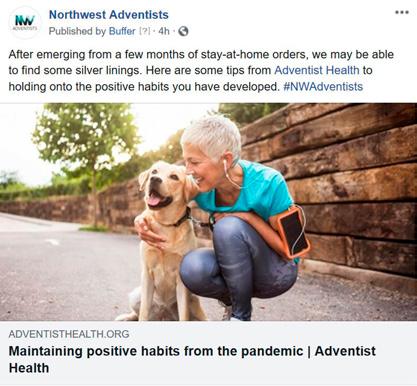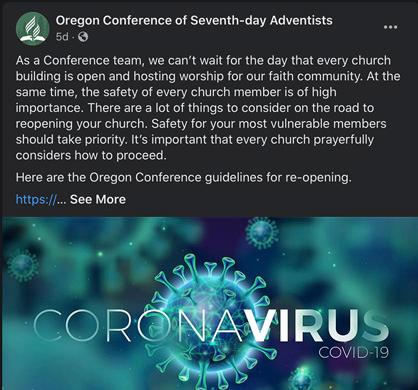
15 minute read
LOVING LIKE JESUS
CREATING A CULTURE OF EVANGELISM
by S. JOSEPH KIDDER
“Young man,” she said. “We don’t come to God’s house looking like that. You should show some respect and rethink how you look.”
Wordlessly, the boy spun on his heels and walked out the front door. He hasn’t been back.
This tragic true story forces us to ask some critical questions. What is the culture of our church? Are we a “come and get clean” kind of church or a place only for the “already clean”? Does the culture of our weekly worship services and small groups invite people to “come as they are” and seek love, help and healing? Do we know how to receive broken sinners in the midst of their pain, or does the culture of our church work against people admitting their hurts and faults until they are all better?
Leaders often ask me what programs can churches use to produce fully devoted disciples who are engaged in evangelism, ministry, worship and hospitality. Specifically, they want to know how a church can have a successful evangelism program.
My answer surprises some. I’m convinced it’s better for our church to have an evangelistic culture than just a series of evangelistic programs. While there are many great programs that do reach some people, there is a sense of dissatisfaction among church members, pastors and the community regarding evangelistic programming and the fact they often have very little effect on increasing local church membership. 1
INTRODUCTION CONTINUED
In a church with a program-driven approach to evangelism, sharing the gospel can become something reserved for certain people at certain times, like when the evangelism team goes out visiting or when the church organizes public evangelistic meetings. Culture, on the other hand, refers to the way of life of a group of people — the behaviors, beliefs, values and symbols they accept, generally without thinking about them and that are passed along by communication and imitation from one generation to the next.
The heart of evangelism is taking the time to know people so we see past the stereotypes, imperfections and our own ideals of what they should look like or how they should act — as modeled by Christ in the New Testament.
INGREDIENTS for CHANGE
HERE ARE SEVEN SPECIFIC THINGS YOU CAN DO TO HELP CREATE AN 1 EVANGELISTIC CULTURE IN YOUR LOCAL CHURCH.
The Gospel: The Fuel for an Evangelistic Culture
WE GET EXCITED ABOUT SPORTS, food and politics. In the same way, if we want to create a culture in our churches where it’s natural for members to talk about the gospel message with non-Christians, then we need to help our members fall deeply in love with Christ. The gospel message is the fuel that feeds an evangelistic culture.
It is imperative that we understand and display the beauty of the gospel message. When we truly grasp the depth of our sin, the wonderful holiness of God, the perfection of Christ and the depth of His suffering for us, the power of His resurrection, and the gift of eternal life for all who repent and believe, our affections, love and commitment for Christ will grow (Col.3:1–17).
The gospel says that we don’t have to evangelize in order to earn God’s love. It is the job of the Holy Spirit to convict and save. Remember that when someone rejects the gospel they are rejecting God, not you — His messenger.
C R E A T I N G A C U L T U R E OF EVANGELISM
3
Love and Acceptance: The Atmosphere of an Evangelistic Culture
A FEW YEARS AGO, I was in the middle of a sermon. I was pressing the point that God, in Jesus, was inviting us home. I was talking about how it felt to be far away from home and desperate to get back. Suddenly, in the middle of my sermon, a woman stood straight up and said loudly, “I want to come home!”
She was weeping. I stopped preaching, walked over to where she was and put my arm around her. Right then and there, I asked everyone to join us in prayer as she spoke directly to God about where she was in life and what she needed from Him.
The following week, a longtime church member brought up the incident from the previous weekend. “Things like that have no place in church,” she said. “That was awkward and embarrassing and out of order for church worship service. Besides, I have more religion in my little finger than what she has in her whole body.”
I was shocked and didn’t know how to respond. But I was impressed to share with her how Jesus longs to embrace us rather than condemn us (John 8:1–11) as we anoint Him with overflowing worship and bathe His loving presence with our tears of repentance (John 12:1–3).
Many will leave a church that is judgmental and unloving, but few will leave a church home in which they feel accepted. Acceptance of the gospel will lead us to love and accept others regardless of who they are.
Prayer: The Power of an Evangelistic Culture
EVANGELISM SEEMS a hopeless task. How are we going to equip and encourage people to call spiritually dead people to embrace life? A church sharing the gospel must be committed to prayer.
“The Saviour knew that no argument, however logical, would melt hard hearts or break through the crust of worldliness and selfishness. He knew that His disciples must receive the heavenly endowment (the Holy Spirit); that the gospel would be effective only as it was proclaimed by hearts made warm and lips made eloquent by a living knowledge of Him who is the way, the truth, and the life. The work committed to the disciples would require great efficiency; for the tide of evil ran deep and strong against them. A vigilant, determined leader was in command of the forces of darkness, and the followers of Christ could battle for the right only through the help that God, by His Spirit, would give them.” 2
In prayer, we go to the Lord with a confession of our insufficiency for evangelism and His sufficient strength. God alone can make the seeds we sow spring up to eternal life in their hearts.
Prayer for each other and our loved ones should happen every day of the week, not only on Sabbath. When we do gather as a congregation to pray, make certain corporate prayers include praying for the lost. Be sure these prayers are done with an attitude of concern and not condescension. The culture of the church becomes decidedly more evangelistic as the prayers are infused with a burden for those who are not followers of Jesus Christ.
One gentleman who tried for years to reach his daughter for Christ through reason and arguments was convicted of his need to pray instead. Through prayer and opening his heart to the internal workings of God, his daughter noticed changes in him. This led her to want to know more about the God who could transform her father and brought her back into relationship with them both.
4
Friendship: The Glue of an
Evangelistic Culture
A FOURTH INGREDIENT is training, the blueprint for an evangelistic culture. We want our churches to have an evangelistic culture rather than merely evangelistic programs. That doesn’t mean there is no place for church leaders to organize and equip people to share the gospel. In fact, a love for the gospel and prayer will motivate Christians to want to be trained in ways of witnessing and for a lifestyle of evangelism. While evangelism will come naturally to some people in your congregation, there will be many people who love the gospel and pray faithfully but still need to be equipped to share the gospel. Paul gave us a formula that has endured the test of time: “And the things you have heard me say in the presence of many witnesses entrust to reliable people who will also be qualified to teach others” (2 Tim. 2:2). Paul is training Timothy, Timothy is training his leaders, and those leaders are training the next generation. Devote time and resources to help your members find their own evangelistic voices. Once the process and principles are clear, people can use the context and circumstances to best witness to each individual. 5
Lifestyle: The Heart of an
Evangelistic Culture
PAUL REMINDS US to live a lifestyle conducive to evangelism: “I urge you to live a life worthy of the calling you have received. Be completely humble and gentle; be patient, bearing with one another in love. Make every effort to keep the unity of the Spirit through the bond of peace” (Eph. 4:1–3).
So how do Christ-centered churches develop a culture of discipleship, evangelism and mutual care? Paul admonishes that we are to “share with God’s people who are in need. Practice love and hospitality.” These are what Christians do by virtue of being citizens of Christ’s kingdom. We “live as citizens worthy of the gospel,” which means “striving side by side for the faith of the gospel” (Phil. 1:27, my translation; cf. 3:20).
Lifestyle is not programs; it is building uplifting and supportive relationships on the basis of love and hospitality. Canceling some programs and encouraging members to take the time to prioritize their schedules based on what it would look like if Jesus was in charge of their time might give the members more opportunity for discipling and evangelism. Challenge members to devote three to four hours every week in community ministry. Additionally, make sure there are social activities on the calendar that are welcoming to the unchurched. FRIENDSHIP IS FORMING relationships that lead to a better understanding of each other. Friendship is breaking bread together, being a shoulder to cry on, a listening ear and a cheerleader. It is about rejoicing in personal victories and holding each other up when things fall apart. It is bringing cookies and casseroles to your neighbors. It’s building awareness of other people and seeing them with the love of God’s eyes.
Learn how to pursue and share the gospel with friends, family, co-workers, classmates, roommates, etc. Christians are usually less fearful of sharing the gospel with people they know than with people they don’t. Seventy-five percent of those who come to the Lord and the church come as a result of friendship evangelism. 3
Commit to the people you are ministering to. It can take up to three years after the first contact with someone before they are ready to commit to Christ. 4
Because unbelievers are exposed to the gospel through the everyday relationships and interactions they have with Christians, we are instructed to make the best use of our time around seekers, acting wisely, speaking graciously and giving informed answers about the gospel (Col. 4:5–6; see also 1 Peter 3:15–16).
“The example of Christ in linking Himself with the interests of humanity should be followed by all who preach His Word and by all who have received the gospel of His grace. We are not to renounce social communion. We should not seclude ourselves from others. In order to reach all classes, we must meet them where they are. They will seldom seek us of their own accord. Not alone from the pulpit are the hearts of men touched by divine truth. There is another field of labor, humbler, it may be, but fully as promising. It is found in the home of the lowly, and in the mansion of the great; at the hospitable board, and in gatherings for innocent social enjoyment.” 5
Do not be satisfied with confining the gospel proclamation to the church building, which places the burden upon the seeker to come to us for the gospel message. Rather we are to go to them.
7
Testimonies: The Model and Inspiration of an Evangelistic Culture
CREATE A CULTURE RIPE for evangelism through the regular use of testimonies. Even in a church with a regular attendance of 25 adult worshippers, there are enough stories to fill every Sabbath service for an entire year! Start listening for stories you know would be appropriate to share and would increase the culture of evangelism. Every one of us has a story of redemption and God’s work in our lives.
Testimonies don’t have to be reserved for church services to inspire others to live out an evangelistic culture.
Tim was married to a Christian woman but not interested in Christianity for himself. His wife, Michelle, spent much time throughout their marriage praying for his heart to be softened and sharing new understandings about Jesus. One Sabbath, after several years of trying to influence her husband for God, Michelle was shocked to see Tim standing in the baptismal tank ready to make a commitment for Jesus.
A church member who had befriended Tim years before had recently been studying with him because Tim wanted to know more about the Jesus his wife was talking about. Tim is one of many for whom conversion has been more of a slow process than a quick 180- degree turn.
We are often the most passionate about things at the point of discovery, so people just coming to faith are often in the best position to speak. They still have a wide circle of un-churched and de-churched friends and are filled with the awe and excitement that comes from newly meeting Jesus. Their passion and witness could lead to revival!
Even with a renewed focus and push for evangelistic programs over the past few years, the Adventist Church only had membership growth of 1.5% in the North American Division from 2012 to 2013 per the 2014 Annual Statistical Report as found at http://www. adventiststatistics.org/ (accessed Aug 21, 2014).
Ellen G. White, Acts of the Apostles, (Mountain View, CA: Pacific Press, 1911), p. 31.
S. Joseph Kidder, The Big Four: Secrets to a Thriving Church Family, (Hagerstown, MD: Review and Herald, 2011), p. 116.
Jesus’ Methods: Befriending and Relationships, retrieved on 05/6/2014 from http:// www.internetevangelismday.com/relationships.php.
C R E A T I N G A C U L T U R E OF EVANGELISM
CONCLUSION
A CULTURE OF EVANGELISM involves both spiritual renewal and intentionality in all areas of life. There is no program that creates an evangelistic culture. Instead, it requires teaching, modeling and praying until we realize that sharing the gospel is our privilege and responsibility.
A church with such a culture will be far more fruitful than a church with even the most effective programs and strategies. We want evangelism to become the normative experience of every believer in our churches and for them to share the gospel in the context of their everyday relationships.
The next time a weary soul walks across your path or into your church lobby, even if they don’t look like you, I pray they will find the heart of Jesus. I pray they will find welcoming balm for their aching heart. I pray they will find a home.

by S. Joseph Kidder
CONNECT WITH NORTHWEST ADVENTISTS ONLINE Join the thriving community sharing daily inspiration and encouragement, bringing us all closer together. Discover more today!



Follow on social media for these posts and so much more @NWADVENTISTS







Sermons, music and more available at
GLEANERNOW.COM





Makes about 30 meatballs. Serves 6–8 people.
INGREDIENTS: MEATBALLS 1 ¾ cup cooked lentils 4 eggs 1 medium onion, chopped fine 1 cup soda crackers or bread crumbs, finely ground 1 cup grated cheddar cheese ½ cup walnuts or pecans, chopped fine ½ teaspoon sage ¾ teaspoon salt SAUCE ½ cup barbecue sauce 1 12-ounce jar of pineapple-apricot marmalade
DIRECTIONS: » Measure and mash or purée the lentils. » In a large bowl combine the lentils, chopped onion, crackers or bread crumbs, nuts, sage, and salt. Mix together and taste for salt. When satisfied, mix in the eggs and let the mixture rest. » In a separate bowl, stir together the barbecue sauce and marmalade and set aside. » Roll or scoop the mixture into balls and pan-fry.
Depending on the size of ball there should be around 30 meatballs. » After frying, arrange the meatballs as a single layer in a baking dish and cover with the sauce. » Bake at 350 F for 40–45 minutes.
Let’s eat!
These are great to serve at a party. Take them out of the oven, cool for 20 minutes or so, and serve with toothpicks. My family loves them with roasted or smashed potatoes and green beans. However you choose to enjoy them, just know they won’t last long!
Jennifer Wintermeyer, NPUC food editor and columnist
RECIPE NOTES
If you are refrigerating these to serve soon, cover the meatballs with sauce, cover the dish and tuck in the refrigerator. If you are freezing this dish for later, do not cover the meatballs with the sauce. Wait until the meatballs are completely cool in the dish, cover the dish and freeze. To bake, remove from the freezer 25–30 minutes to let them thaw before pouring the sauce over them. Then bake as directed. Want to serve them with a different sauce? These little guys will take what ever sauciness you throw at them. These are delicious with marinara sauce, a mushroom cream sauce or a spicy ginger-sesame glaze.











